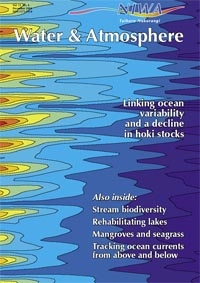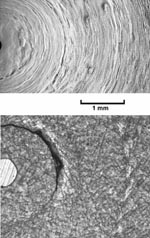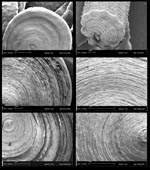PDF of this article (282 KB)

Juan Sánchez Di Tracey Helen Neil Peter Marriott
Thickets of coral on the deep-ocean floor have secrets to tell us about past environmental conditions. But first we have to get them to tell us their age.

With their segmented trunks made of alternating calcareous white nodes and organic dark internodes, “bamboo corals” get their common name from their tropical plant lookalikes. These non-tropical octocorals (so called for their eight-branching structure) grow on the deep-ocean floor and on seamounts in New Zealand’s Exclusive Economic Zone. So far, more than 20 species of bamboo coral have been identified. Long-lived and slow-growing, they can reach several metres in height and can form dense thickets. Together with other kinds of stony and encrusting corals, bamboo corals provide an ideal habitat for small invertebrates and shelter for juveniles of some of our commercial fish species. Bottom trawling and other commercial fishing activities have begun to endanger these vital habitat-forming corals in other parts of the world. It’s important, therefore, to understand as much as we can about the New Zealand bamboo corals so we can manage them and protect them from population collapse. One of the first requirements is determining their age.
Tree rings as a model
Finding an appropriate method to date octocorals has not been an easy task. For many years tree rings have been used as a way of dating past events, and this technique has been an excellent source of information on environmental events such as climatic changes which affect the growth of the trees. The rate of growth in trees depends on the availability of resources: slow growth produces dark bands, fast growth yields light bands. Tree rings are fingerprints of the growth process, and when good age validation is possible, differences between years can be correlated with climate events, fires, hurricanes, and droughts. Similar growth structures are produced by many organisms, including corals.
Learning to read coral rings
Octocoral growth rings were first studied in the 1970s. Ages of two shallow-water gorgonian corals from the Eastern Pacific (Muricea californica and M. fruticosa) were experimentally validated, suggesting that the growth rings were annual. A later study on an Atlantic gorgonian coral (Leptogorgia setacea) produced similar results. The two studies suggested life spans of less than 30 years for these shallow-water octocorals. More recently, some studies on deep-water gorgonians (such as Primnoa resedaeformis) using radiometric dating with a lead isotope (210Pb) have shown ages of up to 100 years. Scientists have assumed that other octocorals such as sea pens (Halipteris willemoesi) also have annual rings, and so reach ages of over 50 years. Bubble-gum corals (Paragorgia arborea) from New Zealand have been found to be older than 300 years by means of radiocarbon dating. However, many scientists have noticed that the growth rings from gorgonian corals and sea pens are not as discrete and clear as the tree rings. This is because the skeleton (or axis) of these corals has a high organic content (scleroproteinaceous) which can interact with the fixatives used during analysis, or even change in size as the result of dehydration or denaturation.
Bamboo coral to the rescue
Our New Zealand bamboo corals have turned out to be a good alternative for coral growth-ring studies. They have a highly calcified skeleton with minimum organic content and therefore there is less chance for artifacts to occur. Polished thin sections of the bamboo coral calcareous axis are usually blurry and crystalline, so there is some difficulty in discerning the growth rings. Nonetheless, the bamboo coral sections have enabled us to note major differences in the growth density, and in some species most rings were clearly visible. The white calcareous nodes of bamboo corals form a platform of elevated rings that seem to serve as a place for the organic internode to fasten. After preparing the coral samples using diluted hypochlorite (commercial bleach), we observed that the growth rings were very readable, but high magnification and resolution were required to enable accurate counts.
Up close and personal with SEM


For a closer view we used a scanning electron microscope (SEM) at Industrial Research Ltd to look at prepared pieces of the calcareous skeleton. The SEM is particularly suitable for looking at surfaces and textures that would be undetected using a light microscope. Since the calcite from bamboo corals is white and crystalline, we first covered the coral pieces with a microscopic coating of carbon (which is conductive) to make the image. The SEM images let us distinguish the crystalline structure of the calcite forming the white calcareous nodes of the bamboo coral trunk. Further SEM investigation into several species of bamboo coral revealed that most Isididae corals, including the subfamilies Mopseinae and Keratoisidinae, had clear, consistent, and visible growth rings. This eliminated the problem of ring discrimination and also provided evidence that the rings were discrete and clearly separated. High-magnification SEM images revealed elevated structures separating the rings in bamboo corals.
Before this study it was thought that the growth rings from bamboo corals would be annual. However, we found some species with trunks as small as 17 mm had about 430 growth rings. This suggests that these corals are either extremely old, or that the rings are not annual – they may be semi-annual. We are now in the process of validating the ring counts, and therefore age, of the bamboo and other corals using the independent radiometric decay age-validation technique of lead-210 to radium.
A key for unlocking deep-sea secrets
These long-lived bamboo corals are potentially an excellent source of information on oceanic and climatic events which can affect the growth of corals. Measurable records of climatic changes are stored in the coral’s calcite skeleton. By counting the calcite rings in bamboo corals we can apply ages to the identified climate changes. Results to date show that bamboo corals seem to be an ideal organism for recording centennial climate events in the deep ocean.
In New Zealand, and particularly at NIWA in Wellington, we have one of the largest collections of bamboo corals in the world. Most of these corals are endemic to the region. In the Atlantic and other parts of the Pacific, bamboo corals are quite rare, and much smaller than the New Zealand specimens. We consider ourselves fortunate to have access to such deep-sea treasures. They contain invaluable information about the age of deepwater coral communities, as well as about past climate events and trends.
Juan Sánchez was a postdoctoral research fellow at NIWA and is now at Universidad de los Andes in Colombia. Di Tracey, Helen Neil, and Peter Marriott are based at NIWA in Wellington.
Teachers’ resource for NCEA AS: Biology 1.2, 2.9; Chemistry 1.2; Science 1.2. See other curriculum connections at www.niwa.co.nz/pubs/wa/resources
